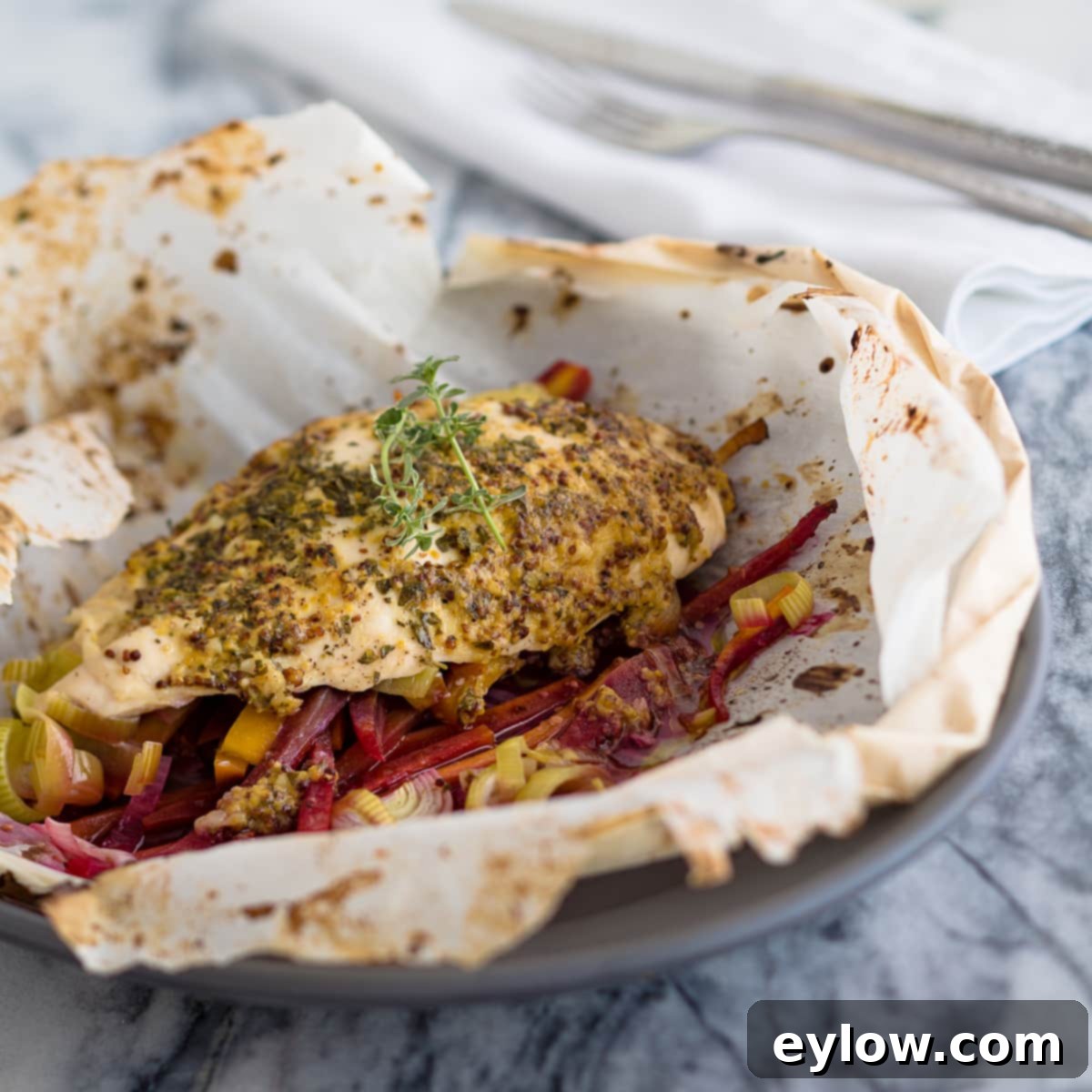Effortless & Healthy Baked Chicken in Parchment Paper (En Papillote)
Discover the delightful art of baked chicken in parchment paper, a method known in French cuisine as “en papillote.” This elegant cooking technique delivers a tender, juicy, and incredibly flavorful meal with minimal effort and surprisingly easy cleanup. It’s a fantastic make-ahead option that allows you to prepare individual chicken and vegetable packets a few hours in advance, then simply bake them when you’re ready to serve. Each beautifully sealed packet feels like opening a personal present, making it perfect for both weeknight dinners and impressive entertaining. Follow along as we guide you through this simple yet sophisticated cooking experience, step by step.
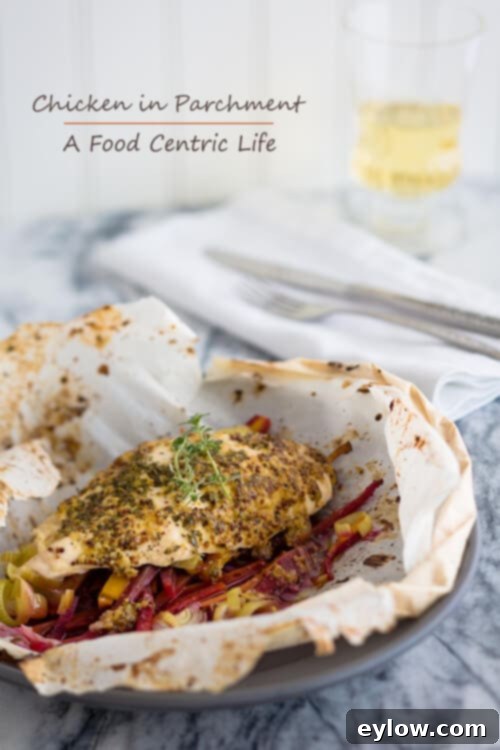
Baking chicken in parchment paper is a straightforward process that locks in moisture and infuses every bite with delicious aromas. It involves placing boneless, skinless chicken breast cutlets on a bed of thinly sliced, vibrant vegetables, all seasoned with a savory mixture of whole grain mustard, aromatic fresh herbs, and a drizzle of olive oil. Once sealed into individual parchment packets, the ingredients gently steam in their own juices, resulting in perfectly cooked chicken and crisp-tender vegetables. This ancient French technique is not only healthy and flavorful but also offers incredible versatility, allowing you to easily customize it to your taste and what you have on hand.
[feast_advanced_jump_to]
Why You’ll Love This En Papillote Chicken Recipe
This method of baking chicken in parchment paper is more than just a recipe; it’s a culinary revelation that offers numerous benefits for home cooks. Here’s why it’s bound to become a favorite in your kitchen:
- Effortless Meal Prep: One of the biggest advantages is the ability to assemble these chicken parchment packets hours, or even a day, before baking. This makes it an ideal solution for busy weeknights or when hosting, allowing you to focus on other tasks until it’s time to pop them into the oven. The convenience of simply pulling them from the fridge and baking means less stress and more time to enjoy your evening.
- Fun, Impressive, and Easy: The individual packets, once puffed from the steam and beautifully browned, look incredibly impressive when brought to the table. Each guest gets to open their own “present” of a delicious meal. Yet, the preparation is surprisingly simple, requiring basic knife skills and a bit of folding. It’s a guaranteed crowd-pleaser that looks like you spent hours in the kitchen, without the actual time commitment.
- Unmatched Versatility: This recipe is a canvas for your culinary creativity. The core method remains the same, but you can easily swap out vegetables, change up the herbs and spices, or experiment with different liquids (like wine or broth) to create an entirely new flavor profile every time. It adapts beautifully to seasonal produce and personal preferences, ensuring you never get bored.
- Healthy and Flavorful: By steaming the chicken and vegetables within the sealed parchment, moisture and nutrients are locked in, resulting in incredibly tender protein and perfectly cooked, vibrant vegetables. This method requires minimal added fat, making it a naturally healthy cooking choice that doesn’t compromise on taste or satisfaction.
- Quick & Easy Cleanup: Since all the cooking happens inside the parchment paper, cleanup is a breeze! There’s no greasy baking dish to scrub; simply discard the parchment paper after serving. This is a huge bonus for anyone looking to minimize post-dinner chores and enjoy more time relaxing.
- Perfectly Cooked Results Every Time: The sealed environment ensures even cooking and prevents the chicken from drying out, while the vegetables emerge crisp-tender and infused with the flavors of the sauce and herbs. It’s a foolproof method for consistently delicious and moist results, making you feel like a pro chef.
Essential Ingredients for Parchment Baked Chicken
Crafting these delicious parchment packets starts with a selection of fresh, high-quality ingredients. Here’s what you’ll need, along with tips for choosing and preparing each component:
- Chicken: For best results and quick cooking, use boneless, skinless chicken breasts. Thinly sliced chicken breast cutlets are ideal as they cook quickly and evenly. If you have larger chicken breasts, you’ll simply slice them horizontally to create thinner cutlets, ensuring a consistent cooking time with the vegetables. This also allows for better flavor absorption from the seasonings.
- Mustard: Whole grain Dijon mustard is a key flavor enhancer, adding a tangy, slightly spicy, and robust depth that complements the chicken and vegetables beautifully. Its coarse texture also helps create a flavorful paste that clings to the chicken.
- Oil: Extra virgin olive oil is preferred for its rich, fruity flavor and heart-healthy properties. Avocado oil is another excellent alternative, offering a neutral taste and high smoke point, which is beneficial for subtle flavors. The oil helps distribute the flavors and adds a touch of necessary moisture and richness to the dish.
- Herbs: Fresh thyme leaves are highly recommended for their earthy, slightly floral, and subtly peppery aroma that pairs wonderfully with chicken and vegetables. Using fresh herbs elevates the overall freshness and vibrancy of the dish, creating a more aromatic and gourmet experience.
- Carrots: Classic orange carrots are perfect, providing a natural sweetness and beautiful color. However, don’t hesitate to experiment with red, purple, or even white carrots to add a beautiful pop of color and visual interest to your packets. Ensure they are sliced thinly into matchsticks to cook through at the same rate as the chicken.
- Leek: A delightful and often overlooked member of the onion family, leeks provide a milder, sweeter, and more delicate flavor than traditional onions, with a tender texture when cooked. Remember to use only the pale green and white parts, as the dark green tops can be tough and fibrous. Thorough cleaning is essential to remove any hidden sand or dirt trapped between its layers.
- Lemon: Fresh lemon is crucial! A generous squeeze of fresh lemon juice brightens the entire dish, cutting through the richness and adding a zesty, aromatic finish that really makes the flavors sing. If fresh lemon isn’t available, a splash of dry white wine can offer a similar acidic note and enhance the steaming liquid within the packet.
Chef’s tip on buying chicken breasts: For this “en papillote” technique, you want thin pieces of chicken or chicken cutlets because they cook much faster and more evenly within the sealed packet. You can either purchase pre-sliced chicken cutlets (often labeled “thin-sliced chicken breasts”) or buy two large chicken breasts (approximately 1 ½ – 1 ¾ pounds total) and slice them yourself. To do this, carefully place a large breast flat on a cutting board, hold it steady, and use a sharp knife to slice it in half horizontally from the thickest part to the thinnest, creating two thinner cutlets from each. Aim for an even thickness (about ¾-inch) to ensure consistent cooking. If you’re slicing them yourself, try to keep the knife level to avoid making one side significantly thinner than the other.
Substitutions and Flavor Variations
One of the best aspects of baking in parchment is how incredibly adaptable it is. Feel free to get creative with your ingredients based on what you have in your pantry and what flavors you love:
- Herb Swaps: If fresh thyme isn’t readily available, dried thyme can be used (use about ⅓ of the fresh amount, as dried herbs are more potent). For a completely different flavor profile, swap thyme for fresh chopped parsley, fragrant dill, savory rosemary, or a delightful combination of Italian herbs like oregano and basil.
- Mustard Alternatives: While whole grain Dijon adds a lovely texture and robust flavor, creamy Dijon mustard works equally well for a smoother sauce that still provides that essential tang. For a milder option, a touch of honey mustard could be used, or even a teaspoon of vibrant pesto for an Italian-inspired twist.
- Vegetable Combinations: Expand beyond carrots and leeks to explore a world of flavors and textures! Consider adding thinly sliced bell peppers (any color), zucchini ribbons, tender asparagus spears, halved cherry tomatoes, fresh spinach, sliced mushrooms, or even very thin potato slices (ensure these are almost paper-thin to cook through). Root vegetables like parsnips or sweet potatoes can also be delicious when julienned.
- Spice It Up: Enhance the flavor profile with a pinch of garlic powder, onion powder, warm smoked paprika, or a dash of red pepper flakes for a subtle, warming kick. A little dried oregano or basil can also add an aromatic, Mediterranean touch. Cumin and coriander can lend an Indian or Middle Eastern flair.
- Liquid Boosts: Instead of lemon juice, a splash of dry white wine (like Sauvignon Blanc or Pinot Grigio) can add sophisticated depth, while chicken broth or vegetable broth can enhance savory notes and ensure moisture. A tablespoon of orange juice can offer a sweeter, citrusy twist.
- Cheese Inclusion: For an extra layer of richness and indulgence, sprinkle a tablespoon of freshly grated Parmesan cheese, crumbled goat cheese, or even a touch of feta cheese over the chicken before sealing the packets. The cheese will melt and become wonderfully creamy.
- Different Proteins: While this recipe focuses on chicken, the “en papillote” method is fantastic for other proteins too! Delicate white fish fillets (such as cod, tilapia, halibut, or sea bass) cook beautifully in parchment, often requiring slightly less baking time (around 12-15 minutes). Succulent shrimp, thin slices of lean pork tenderloin, or even firm tofu can also be successfully cooked this way, making this method incredibly versatile for various dietary needs and preferences.
How to Make Chicken Parchment Packets: Step-by-Step Guide
Making these elegant chicken and vegetable packets is a fun and rewarding process that transforms simple ingredients into a gourmet-style meal. Let’s walk through each step to ensure perfect results and an enjoyable cooking experience:
Gather Your Parchment Paper
First, ensure you have the right material. You’ll need rolls of baking parchment paper, typically found in the baking aisle near plastic film and aluminum foil. It’s crucial to use baking parchment paper and not wax paper, as they are entirely different materials and wax paper is not designed for oven temperatures. A roll that is 15 inches wide is ideal for creating generously sized packets that can comfortably hold your chicken and vegetables without tearing. Here is a recommended brand of parchment paper. Proper parchment is key to the success of this steaming method.
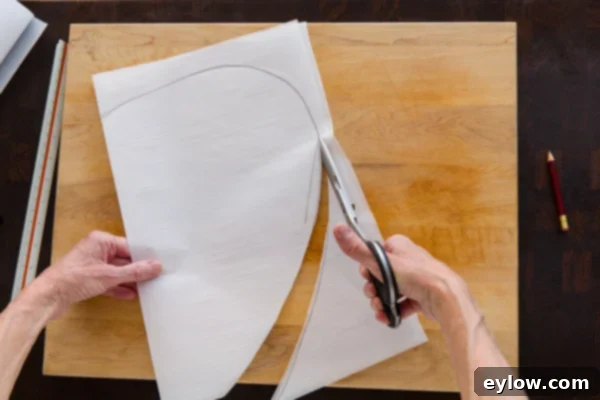
Step 1: Create Your Parchment Hearts
To form the classic and functional heart-shaped packets, start by cutting a piece of parchment paper approximately 18 inches long by 15 inches wide. This size provides ample room for ingredients and sufficient material for sealing. Fold this sheet in half along its 18-inch length, creasing it firmly down the middle to create a 9-inch by 15-inch folded piece. With a pair of sharp scissors, cut a large, fat half-heart shape from the folded edge, similar to how you would cut a paper valentine. When unfolded, this will create a symmetrical heart shape. This shape isn’t just aesthetic; its natural curves facilitate easy folding and sealing, creating a tight pouch that effectively traps steam and cooks the contents to perfection. You’ll need one heart per serving.
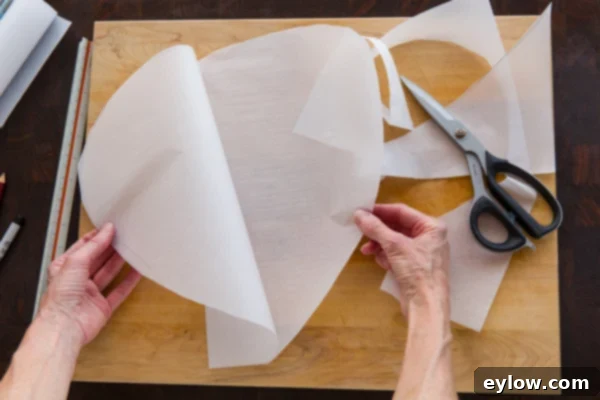
Step 2: Prepare the Vegetables
Evenly sliced vegetables are key to ensuring everything cooks simultaneously and thoroughly within the short baking time. For the carrots, peel them first, then cut them into thin, uniform matchsticks (also known as julienne style). A sharp chef’s knife can accomplish this with practice, but for ease and consistency, especially for those new to julienning, a julienne peeler or a julienne slicer can make this task much quicker and more precise. For the leek, begin by trimming off the tough, dark green top and the root end. You will only use the white and pale green parts, which are more tender and flavorful. Slice the leek in half lengthwise, then thoroughly rinse each half under cold running water to remove any lingering sand or dirt that may be trapped between its numerous layers. Finally, slice the cleaned leek halves crosswise into thin half-circles. These thin, consistent cuts ensure the vegetables become tender and flavorful without overcooking the chicken.
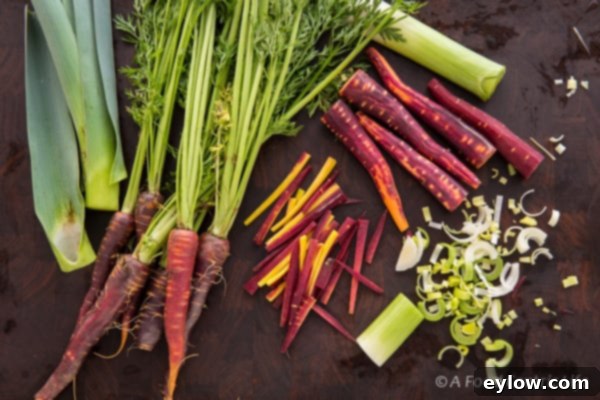
Step 3: Prepare the Chicken Cutlets
If you purchased large, thick boneless, skinless chicken breasts instead of pre-sliced cutlets, this step is absolutely essential for even cooking in a parchment packet. Using a large, sharp knife, carefully slice each chicken breast in half horizontally. The goal is to create thinner, uniform cutlets, approximately ¾-inch thick. Pay close attention to slicing evenly across the entire length of the breast to avoid having one side significantly thinner than the other, which can lead to uneven cooking (one part dry, another still cooking). If your chicken breasts are already thin cutlets, or if you bought cutlets, you can simply skip this step. This preparation ensures the chicken cooks through completely and remains tender within the 15-20 minute baking window.

Step 4: Assemble the Parchment Packets
Now for the fun part – assembling your flavorful individual packets! Lay one parchment heart open on a clean, flat surface, much like an open book. On one half of the heart, near the crease, create a sturdy bed by layering half of your prepared carrots and leeks. This forms a flavorful base for the chicken. Place one chicken cutlet neatly on top of this vegetable bed. Season the chicken generously with sea salt and freshly ground black pepper to taste. In a small bowl, whisk together the whole grain Dijon mustard and olive oil to form a thin, flavorful paste. Evenly spread half of this mustard-oil mixture over the top surface of each chicken breast. Finally, sprinkle each chicken cutlet with a tablespoon of fresh thyme leaves, ensuring they are well distributed for maximum aroma, and finish with a squeeze of fresh lemon juice. These layers ensure every component is seasoned and infused with delicious flavors as it steams.

Step 5: Seal the Packets
Achieving a tight seal is paramount for the “en papillote” method to work effectively, as it traps all the flavorful steam and juices, allowing the contents to cook gently and infuse with aroma. To seal your packet, bring the empty half of the parchment heart over the filled half, aligning the edges perfectly. Starting from the top point of the heart, begin folding and tightly creasing the edges together, working your way down the curved perimeter in small, overlapping increments (every few inches). Each fold should be pressed firmly to create a secure, crimped seal that will prevent any steam from escaping during baking. Continue this process until the entire packet is completely enclosed and sealed, creating a secure, individual cooking environment where the ingredients will gently steam to perfection.


Step 6: Ready to Bake or Refrigerate
Once all your chicken parchment packets are expertly assembled and securely sealed, they are ready for the oven. If you plan to bake them immediately to enjoy a fresh meal, proceed directly to the baking instructions. If you’re utilizing the convenient make-ahead aspect of this recipe, carefully transfer the packets to a baking sheet and refrigerate them. They can be stored for several hours, making meal prep for busy weeknights or entertaining a breeze!
Baking and Serving Your Chicken Parchment Packets
Baking these packets is quick and efficient, and serving them is an experience in itself, revealing the beautifully cooked contents. Here’s how to bring your culinary creation to the table:
Baking Instructions
To bake the chicken packets, begin by pre-heating your oven thoroughly to 425 degrees Fahrenheit (220 degrees Celsius). This high temperature ensures the packets puff up quickly and the ingredients steam efficiently. Arrange the sealed parchment packets on a sturdy metal baking sheet, ensuring they have a little space between them for optimal heat circulation. Bake for approximately 15 to 20 minutes, depending on the precise thickness of your chicken and the cut of your vegetables. You’ll know they’re nearly done when the packets puff up significantly from the steam trapped inside, and the edges of the parchment paper begin to show a slight browning. For absolute certainty, the internal temperature of the thickest part of the chicken should reach 165°F (74°C) as measured by a meat thermometer. Once baked, carefully remove the baking sheet from the oven.
Serving Your Delightful Dish
To serve, transfer each hot, puffed packet directly onto individual plates. Instruct your diners to carefully slit open the parchment packets with a knife or scissors. It’s important to do this with caution, as a burst of hot, aromatic steam will escape as the seal is broken! This dramatic reveal is part of the fun and presentation of the “en papillote” method. The fragrant steam reveals perfectly cooked, tender chicken and vibrant, flavorful vegetables, all bathed in their own delicious juices. Slide the chicken and vegetables out onto the plate, perhaps spooning any accumulated juices over them, and a wonderful, healthy, and visually appealing meal is ready to be enjoyed immediately. Don’t forget to appreciate the minimal cleanup required!

Meal Prep Magic: Assemble Packets Ahead for Busy Weeknights
This “en papillote” method is a true game-changer for effective meal planning and making family dinners during a busy week. The ability to assemble everything in advance provides unparalleled convenience and reduces dinner-time stress. Simply prepare all your chicken and vegetable packets the night before, or even earlier in the day, and store them securely on a baking sheet in the refrigerator. When you arrive home from a hectic day, there’s no frantic chopping or elaborate seasoning required. Just pull the packets out of the refrigerator and allow them to come to room temperature for about 30-45 minutes before baking. This crucial step is important because it ensures more even cooking and helps reduce the overall baking time, preventing the outside from cooking too quickly while the center remains cold. Then, simply bake them as instructed. Serve alongside a simple green salad, some crusty bread, or a side of quinoa or rice, and a wholesome, delicious dinner is on the table with minimal fuss. This advanced preparation frees up valuable time, allowing you to enjoy your evenings without the stress of last-minute cooking.
Tips for Perfect Parchment Baked Chicken
While this method is quite forgiving, a few simple tips can elevate your results from good to absolutely exceptional, ensuring tender chicken and vibrant vegetables every time:
- Slice Evenly: This is arguably the most important tip. Ensure all vegetables (like carrots and leeks) and chicken cutlets are sliced to a similar, relatively thin thickness. This guarantees everything cooks through at the same rate. Unevenly cut ingredients will result in some components being overcooked while others are still undercooked.
- Don’t Overfill: Resist the temptation to stuff the packets too full. Overfilling can make it incredibly difficult to seal them properly, leading to steam escaping during baking. It also prevents even heat distribution within the packet, hindering proper cooking. A good rule of thumb is to leave some headspace.
- Seal Tightly: The entire success of the “en papillote” method relies on trapping the steam. Take your time to create a tight, crimped, and secure seal around the entire edge of the heart-shaped parchment. Any gaps will allow steam to escape, potentially resulting in drier chicken and less tender vegetables.
- Preheat Your Oven Thoroughly: Always preheat your oven to the specified temperature before placing the packets inside. A properly hot oven ensures the packets begin steaming immediately upon entering, creating that perfect moist, tender interior.
- Resist Peeking: As tempting as it may be to check on your meal, avoid opening the packets during baking. Every time you open one, steam escapes, interrupting the cooking process and potentially drying out the delicious contents. Trust the process!
- Use a Baking Sheet: Always place your parchment packets on a sturdy metal baking sheet. This provides stability, makes it easy to transfer them in and out of the oven, and will catch any accidental leaks, keeping your oven clean.
- Check for Doneness: While visual cues like puffing and browning are good indicators, the safest and most accurate way to ensure chicken is cooked through is to use a meat thermometer. The internal temperature of the thickest part of the chicken should read 165°F (74°C).
Delicious Serving Suggestions
Your beautifully baked chicken in parchment paper is often a complete and satisfying meal in itself, thanks to the protein and vegetables cooked together. However, it can be wonderfully complemented by a variety of side dishes to round out your dining experience. Here are some ideas to enhance your meal:
- Simple Green Salad: A crisp, fresh green salad with a light vinaigrette dressing offers a refreshing, vibrant contrast to the warm, savory flavors of the chicken and steamed vegetables.
- Crusty Bread: Serve with a good quality, crusty artisan bread or a baguette. This is perfect for soaking up all the flavorful, aromatic juices that accumulate at the bottom of the parchment packet – don’t let those delicious pan drippings go to waste!
- Grain Sides: Pair your chicken packets with a classic side of fluffy white rice, nutty brown rice, light and airy quinoa, or quick-cooking couscous. These grains absorb the flavors from the chicken packets beautifully and add a satisfying carbohydrate component to the meal.
- Roasted Potatoes: For a heartier and more comforting meal, serve alongside small roasted new potatoes, crispy potato wedges, or even mashed potatoes.
- Light Pasta: A simple, light pasta dish, such as angel hair pasta or orecchiette tossed with a touch of olive oil, fresh garlic, and extra herbs, can be a wonderful and easy accompaniment.
Frequently Asked Questions About Parchment Baked Chicken
Here are answers to some common questions about this versatile and delicious cooking method:
- Can I use aluminum foil instead of parchment paper? While parchment paper is highly recommended for its non-stick properties and ability to create a perfect steam-trapping seal, aluminum foil can be used as an alternative if you don’t have parchment. However, foil can sometimes stick to the food, especially with acidic ingredients, and it doesn’t offer the same visual appeal as the beautifully puffed parchment. If using foil, ensure you create a very tight, crimped seal to retain maximum moisture.
- Can I use other types of protein in “en papillote”? Absolutely! The “en papillote” method is incredibly versatile and works wonderfully with various proteins. Delicate fish fillets (such as cod, salmon, halibut, or snapper) cook beautifully in parchment, often requiring slightly less baking time (around 12-15 minutes). Succulent shrimp, thin slices of lean pork tenderloin, or even firm tofu or tempeh can also be successfully cooked this way, making this method incredibly adaptable for different tastes and dietary needs.
- How long do leftovers last and how should I store them? Leftovers should be transferred from the parchment paper to an airtight container as soon as they have cooled down. They will stay fresh and delicious in the refrigerator for 3-4 days. When reheating, gently warm them in the microwave or a moderate oven to retain moisture and flavor.
- Can I freeze assembled raw packets? Freezing assembled raw packets is generally not recommended. The textures of some vegetables, like carrots and leeks, can change upon thawing and cooking, becoming softer or more watery. It’s best to assemble and refrigerate for up to 24 hours. If you want to freeze cooked chicken and vegetables, remove them from the parchment paper after baking and cooling, then freeze them in an airtight container for up to 3 months for best quality.
- What if my packets don’t puff up significantly during baking? If your packets don’t puff up significantly, it usually means the seal wasn’t completely airtight, and some steam managed to escape. While the food will still cook and be delicious, it might be slightly less moist than perfectly sealed packets. Don’t worry, the meal will still be great! Just ensure you crimp the edges very tightly on subsequent attempts to create a better seal.
📖 Recipe: Baked Chicken in Parchment Paper

Baked Chicken in Parchment Paper
Sally Cameron
Pin Recipe
Equipment
-
baking parchment paper 4 18″x15″ pieces
Ingredients
- 1 ¼ pounds boneless skinless chicken breast 2 large chicken breasts
- ¼ teaspoon sea salt
- ¼ teaspoon ground black pepper
- 2 tablespoon whole grain Dijon mustard
- 1 tablespoon olive oil
- 1 tablespoon chopped fresh thyme leaves
- 2 large carrots
- 1 leek
- 1 half lemon
Instructions
Make your parchment hearts
-
Fold pieces of parchment in half along the long side (18″) and crease like a book. Next, cut a large, fat half heart shape from each piece. See photos in the post for example.
Trim the Chicken
-
With a large sharp knife, slice your chicken breast horizontally into cutlets. See photos in the post for example. If baking right away pre-heat oven to 425°F.
Prep the Vegetables
-
Peel carrots and cut in half across the center for more manageable pieces. Cut carrots into long, thin strips (julienne) with a knife. You can also use a julienne peeler (a fun little tool!) or a julienne slicer. For leek, cut off the dark green top and the root end, using only the white and light green part. Slice the leek lengthwise and run under cold water to clean out any dirt or sand. Slice the leek crosswise into thin half moons.
Build the Packets
-
Place half of the carrots and leek on half of the parchment heart. Top with a piece of chicken. Sprinkle chicken with salt and pepper. Mix olive oil and mustard together and spread half on each chicken breast. Sprinkle each with fresh thyme leaves. Squeeze fresh lemon juice over the top of each.
Seal the Packets
-
Starting at the top of the heart, seal packets by creasing and folding every few inches around the heart until you get to the tail end. You want to create a tight seal so the packets will steam.
Bake and Serve
-
Place prepared packets on a metal baking sheet and bake for 15 minutes. If baking later, refrigerate the packets for several hours. Remove from the refrigerator 45 minutes before baking to get the chill off, then bake.
-
To serve, place packet on a plate and slit packet open with a knife or scissors, being careful of the hot steam. Slide contents onto the plate and enjoy.
